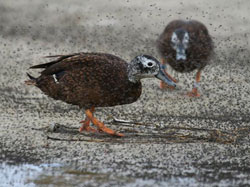
Creature Feature: Laysan Duck
The Laysan duck (Anas laysanensis) is considered to be one of the most critically endangered waterfowl in the world, and is endemic to Hawaiʻi. It is a small duck, dark in color, and is capable of flight but generally stays on the ground to nest, hiding among vegetation. On Laysan the ducks survive mainly on brine flies and utilize a unique hunting strategy. They duck and run along the mudflats of Laysanʻs hypersaline lake, keeping their necks outstretched and bills close to the ground. As clouds of disturbed brine flies rise from the mud they snap them up by quickly opening and closing their bills. The ducks also eat small shrimps and other invertebrates such as insect larvae and moths, as well as grass seeds and some algae. Fossil remains indicate this waterfowl once was found throughout the Hawaiian Archipelago (remains have been identified on Molokaʻi, Oʻahu, Kauaʻi, Maui, and Hawaiʻi as well as the Northwestern Hawaiian Islands), but is now found only on Laysan Island and Midway Atoll (via successful translocation projects). Early in 1911 the population dwindled to near extinction (11 individuals) due to the introduction of rabbits on Laysan that ate all the vegetation on the island. They were also hunted for food. The population grew to approximately 500 individuals, and then plummeted again in 1993 due to drought conditions, introduced insects reducing the duck's food source, and breeding failure. Today, due to intensive conservation efforts, their population on Laysan Island is estimated to be between 503-682 individuals, and the relocated population is doing well on Midway Atoll National Wildlife Refuge and estimated to be close to 350 individuals.
Click Here for more information (you will be directed to a U.S. Fish and Wildlife Service website).
Click Here for more information (you will be directed to a non-NOAA website).
Click Here for more information (you will be directed to a non-NOAA website).

